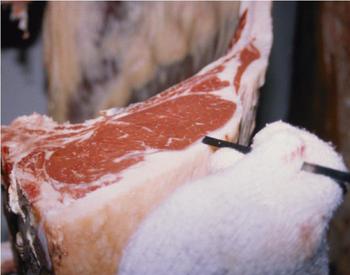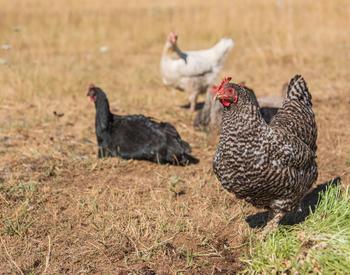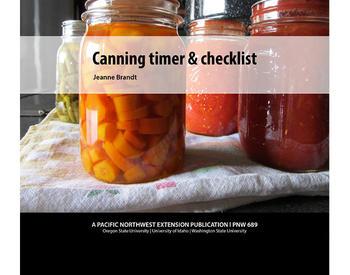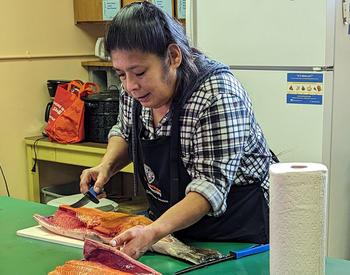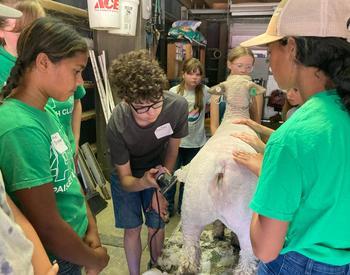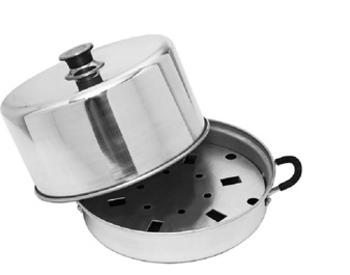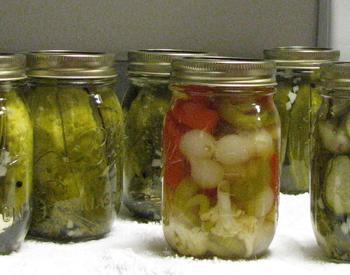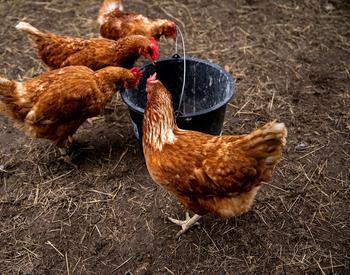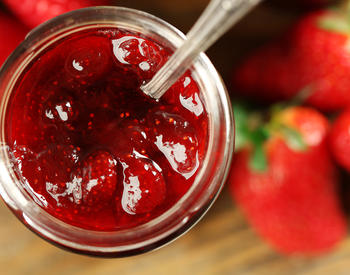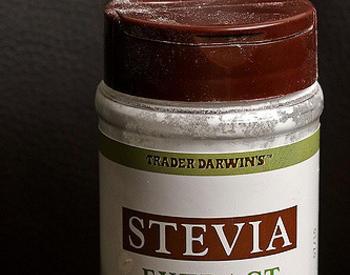Download this publication as a PDF
Cured and smoked poultry meats, especially smoked turkey, have become popular, particularly for the Thanksgiving holiday. Curing and smoking impart a unique, delicate flavor and pink color to poultry meat and increases the refrigerator storage life. Mild cures (relatively low salt) are usually used in preparation for the smoking process to maintain the poultry flavor. Smoked poultry, like ham, can be served hot or cold for sandwiches, salads or party snacks. The bones may be used to replace ham bones for adding flavor to soups or bean dishes.
Preparations
The first step in the curing and smoking process is to obtain the following materials and ingredients:
- Poultry meat.
- Non-iodized salt.
- Sugar and/or brown sugar.
- Cure (containing 6.25% sodium nitrite).1
- Other seasonings according to your recipe.
- Food-grade plastic or stainless steel tub or a large crock or jar smoker.2
- Wood chips or liquid smoke if you choose not to use natural smoke.
- Cheesecloth or stockinette for hanging in the smokehouse.
- Airtight packaging for storage.
Selection of poultry meat
Cured and smoked poultry meat is quite susceptible to rancidity; therefore, it is very important to select poultry that is as clean and fresh as possible. Farm-dressed poultry works well if proper dressing procedures are followed. Chill the birds immediately and cure and smoke within 1–2 days (the sooner the better). Many commercially frozen birds also work very well. Birds with the neck skin removed can be smoked, but it is preferable to fold the flaps of neck skin over the back to reduce drying during smoking.
Curing
Preparation of the brine
Many different curing formulations are available. The following recipe has been used successfully. It is based on an 11.8% total pickup of brine. After injection of brine and soaking in the brine, birds should weigh 11.8% more than before injection and soaking.
- 5 gallons water
- 5 lbs. non-iodized salt
- 3 lbs. sugar (brown sugar can be substituted for all or part of this amount)
- 1/8 lb. cure (containing 6.25% sodium nitrite)
Optional ingredients3 :
- 4 tbsp. black pepper
- 1 cup crumpled bay leaves
- 5 oz. sodium tripolyphosphate (Phosphate will help hold moisture in the meat and slow development of rancidity. It can sometimes be obtained from a local locker plant.)
- 3.3 oz. sodium erythorbate or sodium ascorbate (helps with proper color development and stability)
Commonly used spices include cloves, cinnamon, oil of celery and oil of black pepper.
Follow these procedures when making the brine:
- Use cold water (36-40°F).
- If you use phosphate, dissolve it in 3 gallons of water. Stir it vigorously until it is all dissolved. (Some types of phosphate go into solution slowly.)
- Dissolve the sodium erythorbate (if used) in the water.
- Add the salt, cure, sugar and remaining water and stir until all ingredients are dissolved and the pickle is clear.
- Add additional flavorings and mix well.
Cover brine curing procedure
Soaking time depends on the size of the bird. For example, keep a 2-pound broiler in the brine for 2–3 days. Cure larger birds for one day per pound of carcass.
- Put birds in the curing vat and hold them under the brine with a clean board, stone, or container of water. Be sure the brine fills the body cavity.
- Keep the brine temperature between 32–40°F during the curing process.
- At least once per week, remove birds from the vat, remake the brine and repack the birds to allow uniform contact of the brine with all parts of each carcass.
When the curing time is complete, remove excess salt by washing birds inside and out with fresh, cold tap water and soak them overnight in cold tap water. Remove birds from the water and allow them to drip dry in a cool place for about a half hour before smoking.
Stitch curing procedure
For more rapid curing of large birds, you can inject the brine using a large syringe with a 12-gauge needle. Inject small amounts of brine into numerous locations to ensure uniform distribution into all parts of the carcass. Try to inject into several locations through each hole you make in the skin. Numerous holes in the skin will detract from the appearance of your finished bird. Inject the bird with the pickle solution described above until the carcass weighs 11.8% more than it did before injection. Then place the bird in the remainder of the pickle for 2–3 days. To remove excess salt, rinse the bird in cold tap water for 1 hour and allow to drip dry (about one-half hour).
Smoking and cooking
Liquid smoke procedure
You can brush birds with liquid smoke, put in an oven at 300–325°F and cook to an internal temperature of 165°F. However, many people prefer the natural smoking procedure described below.
Natural smoking
The natural smoking procedure yields a product that is fully cooked and ready to eat. During the smoking process, maintain 80–90% humidity in the smokehouse by dampening the sawdust or wood chips used for the smoke or by placing a pan of water near the heat source and adding water as it evaporates. This will help prevent weight loss and drying of the product. Put birds in stockinettes or cheesecloth, and hang in the smokehouse with the tall end upward with no birds touching each other. You can use various types of hardwood, including apple, hickory, alder and maple. Keep the sawdust or chips moist to prevent flare-ups and to provide humidity.
Use a smokehouse temperature of 170°F for 6–10 hours (depending on amount of smoke desired) until the skin turns the desired light brown color. Then raise the temperature of the smokehouse to 185–200°F and cook the meat until it reaches an internal temperature of 165°F.
Insert a meat thermometer into the thickest part of the breast to determine the internal temperature. This entire smoking and cooking process will take from 16–24 hours for turkeys. During the final cooking phase, some people wrap the birds in foil to prevent excessive drying. The meat can be eaten immediately or it can be stored and eaten cold or properly reheated.
Storage
You should have an excellent product when you remove your smoked poultry from the smokehouse or oven, but improper storage can ruin both the flavor and safety of your masterpiece. Cured and smoked poultry — like all cured meats, especially cured poultry meats — are very susceptible to rancidity.
Cured and smoked poultry requires refrigeration at 40°F or below and will keep for two to three weeks at those temperatures. If longer storage is necessary, properly packaged cured and smoked poultry can be frozen at 0°F for up to one year. Use a plastic bag for refrigerator storage. For long-term frozen storage, use a moisture-/vapor-proof bag.
Note: If using one of the propane smokers that cooks and smokes the meat, follow the recommendation of the manufacturer. Be sure the internal temperature reaches 165°F for safety.
Related articles
- Canned Meat, Poultry and Fish: Problems and Solutions
- Summer Sausage & Deli-Style Meats
- Herbs and Vegetables in Oil
Source: Jan Busboom, Extension Meats Specialist, Washington State University
- 1The cure mentioned above and in the recipe is a commercial cure containing 6.25% sodium nitrite, which gives poultry meat an attractive light pink color after heating. Smoked poultry that does not contain cure will be brownish-white, not pink, after processing. Commercial cures such as “Modern Cure” or “Prague Powder” can sometimes be purchased from small commercial sausage makers. Complete cures such as “Morton’s Tender Quick Curing Salt” can often be purchased in grocery stores or locker plants. Follow the instructions on the container if complete cures are used because they often replace most of the salt and sugar called for in the recipe.
- 2Several types of smokehouses and smokers can be constructed or purchased for smoking meat. Portable electric smokers can also be used. These smokers usually come complete with a pan for wood chips or sawdust and an electric heating unit.
- 3Other flavorings are often added to turkey. These ingredients may include monosodium glutamate, spices, or spice extractives. Commonly used spices include cloves, cinnamon, oil of celery, and oil of black pepper. These ingredients should be used according to personal preference.
